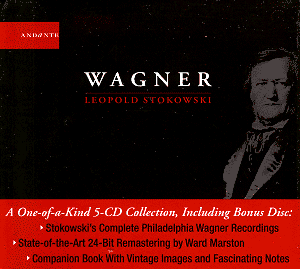













AVAILABILITY
Leopold Stokowski
conducts the music of Richard WAGNER (1813-1883)
CD 1 – 74.09
![]() 1 Rienzi: Overture
Leopold Stokowski (conductor), Philadelphia Orchestra
1 Rienzi: Overture
Leopold Stokowski (conductor), Philadelphia Orchestra
Philadelphia, Academy of Music, 18 November 1926 and 6 January 1927
Source: Victor 6624/5
Matrix: CVE-37004, 37700/12
Lohengrin: Prelude to Act I
Leopold Stokowski (conductor), Philadelphia Orchestra
Philadelphia, Academy of Music, 13 October 1927
Source: Victor 6791
Matrix: CVE-30021/223
Lohengrin: Prelude to Act III 3:20
Leopold Stokowski (conductor), Philadelphia Orchestra
Philadelphia, Academy of Music, 27 March 1940
Source: Victor 17568-B (M-731)
Matrix: CS-0478154-8
Das Rheingold: Symphonic Synthesis 23:10
Arranged by Leopold Stokowski
4 Prelude; "Song of the Rheinmaidens" 4:55
5 "Alberich Steals the Gold" 2:59
6 "Wotan and Loge Descend into Nibelheim" 3:17
7 "Erda's Warning" 4:45
8 "Entrance of the Gods into Valhalla" 7:14
Leopold Stokowski (conductor), Philadelphia Orchestra
Camden, Trinity Church Studio, 4 March 1933
Source: Victor 7796/8 (M-179)
Matrix: CS-75117-1/78-2/80-2/81-2/83-1/84-1
9-12 Die Walküre: excerpts 28:17
9 "Siegmund Comforts Sieglinde" 4:21
10 "Ride of the Valkyries" 4:45
11 "Brünnhilde Pleads Before Wotan" 2:28
12 "Wotan's Farewell and Magic Fire Music" 16:43
Lawrence Tibbett (baritone, track 12)
Leopold Stokowski (conductor), Philadelphia Orchestra
Camden, Trinity Church Studio No. 2, 30 April 1934
Source: Victor 8542/5 (M-248)
Matrix: CS-83102/09 (all take 1)
CD 2 - 73:04
1 Die Walküre: "Magic Fire Music" (orchestral version)
8:19
Leopold Stokowski (conductor), Philadelphia Orchestra
Philadelphia, Academy of Music, 9 April 1939
Source: Victor 15800
Matrix: CS 035419/20
2-5 Siegfried: excerpts 17:45
2 "The Wanderer Questions Mime" 0:44
3 "Nothung! Nothung!" 3:28
4 "Forest Murmurs" 8:19
5 Act III finale 5:14
Agnes Davis (soprano, track 5), Frederick Jagel (tenor, tracks 3 and 5)
Leopold Stokowski (conductor), Philadelphia Orchestra
Camden, Trinity Church Studio No. 2, 10 December 1934
Source: Victor 14845/7-A (M-441)
Matrix: CS-87015/19 (all take 1)
6-8 Götterdämmerung: excerpts 42:31
6 "Dawn and Siegfried's Rhine Journey" 11:14
7 "Siegfried's Death and Funeral Music" 12:56
8 "Brünnhilde's Immolation" and finale 18:21
Agnes Davis (soprano, track 8)
Leopold Stokowski (conductor), Philadelphia Orchestra
Camden, Trinity Church Studio, 25 March, 29 April and 28 October 1933
Source: Victor 7843/7 (M-188)
Matrix: CS-75626-1/27-1/29-1/30-1/32-1/33-2/76-1/77-1/79-1/80-2
9 Götterdämmerung: finale 4:25
Leopold Stokowski (conductor), Philadelphia Orchestra
Philadelphia, Academy of Music, 6 January 1927
Source: Victor 6625-B
Matrix: CVE-37702-2
CD 3 - 74:50
1 Tannhäuser: Overture and Venusberg Music (Paris version)
24:17
Leopold Stokowski (conductor), Philadelphia Orchestra
Philadelphia, Academy of Music, 23 September 1929, 14 March and 29 April
1930
Source: Victor 7262/4 (M-78)
Matrix: CVE 51875/80
2 Tannhäuser: Overture and Venusberg Music (Paris version)
22:49
Leopold Stokowski (conductor), Chorus of 17 female voices,
Philadelphia Orchestra
Philadelphia, Academy of Music, 12 December 1937
Source: Victor 15310/2 (M-530)
Matrix: CS-014382/87
3 Tannhäuser: Prelude to Act III 10:23
Arranged by Leopold Stokowski
Leopold Stokowski (conductor), Philadelphia Orchestra
Philadelphia, Academy of Music, 15 January 1936
Source: Victor 15313/4a (M-530)
Matrix: CS-94651/53
4 Tannhäuser: Overture (Dresden version) 13:02
Leopold Stokowski (conductor), Philadelphia Orchestra
Camden, Trinity Church Studio, 7 November and 5 December 1921
Source: Victor 74758, 74759, 74768
Matrix: C 22808, C 22814, C 24999
5 Tannhäuser: Fest March "Entry of the Guests" 4:17
Leopold Stokowski (conductor), Philadelphia Orchestra
Camden, Trinity Church Studio, 28 April 1924
Source: Victor 6478B
Matrix: C 29051
CD 4 - 72:53
1-3 Tristan und Isolde: Symphonic Synthesis (first version)
35:19
Arranged by Leopold Stokowski
1 Prelude to Act I 9:40
2 "Potion Music" 3:31
3 "Liebesnacht"; "Liebestod" 22:08
Leopold Stokowski (conductor), Philadelphia Orchestra
Camden, Trinity Church Studio No. 1, 16 and 23 April 1932
Source: Victor 7621/4 (M-154)
Matrix: CS-72062/3, 72065/6, 72068/9, 72071, 72075
4-6 Tristan und Isolde: Symphonic Synthesis (second version)
37:31
Arranged by Leopold Stokowski
4 Prelude to Act I 9:45
5 "Liebesnacht" and Act II finale 23:05
6 "Liebestod" 4:41
Leopold Stokowski (conductor), Philadelphia Orchestra
Philadelphia, Academy of Music, 5 April and 7 November 1937 (track 4),
16 and 30 December 1935 (track 5), 20 April 1939 (track 6)
Source: Victor 15202/3A (track 4), 15203B/6S (M-508) (track 5), 15206S
(track 6)
Matrix: CS-07553/5 (track 4), CS-94624/9 (track 5), CS-72075-2 (track
6)
CD 5 - 72:15
1-3 Wesendonck Lieder: selections 15:25
1 III "Im Treibhaus" 7:26
2 V "Träume" 4:23
3 IV "Schmerzen" 3:36
Helen Traubel (soprano)
Leopold Stokowski (conductor), Philadelphia Orchestra
Philadelphia, Academy of Music, 22 December 1940
Source: Victor 18403/4 (M-872)
Matrix: CS 057569/72
4 Die Meistersinger von Nürnberg: Prelude to Act I
9:27
Leopold Stokowski (conductor), Philadelphia Orchestra
Philadelphia, Academy of Music, 15 January 1936
Source: Victor 17567/68a (M-731)
Matrix: CS-94644/46
5 Die Meistersinger von Nürnberg: Prelude to Act III
6:49
Leopold Stokowski (conductor), Philadelphia Orchestra
Camden, Trinity Church Studio No. 1, 17 March 1931
Source: Victor 1584
Matrix: BVE-64078/9
6 Parsifal: Prelude to Act I 14:32
Leopold Stokowski (conductor), Philadelphia Orchestra
Philadelphia, Academy of Music, 28 November 1936
Source: 14728/1
Matrix: CS-03116/9
7 Parsifal: Act III: "Good Friday Spell" 11:50
Leopold Stokowski (conductor), Philadelphia Orchestra
Philadelphia, Academy of Music, 28 November 1936
Source: Victor 14730/1 (M-421)
Matrix: CS-03120/3
8 Parsifal: Symphonic Synthesis from Act III 14:09
Arranged by Leopold Stokowski
Leopold Stokowski (conductor), Philadelphia Orchestra
Camden, Trinity Church Studio No. 2, 7 April 1934
Source: Victor 8617/8
Matrix: CS-82176/9
![]() ANDANTE AND 1130 [1131-1135]
[5 CDs 367.11]
ANDANTE AND 1130 [1131-1135]
[5 CDs 367.11]